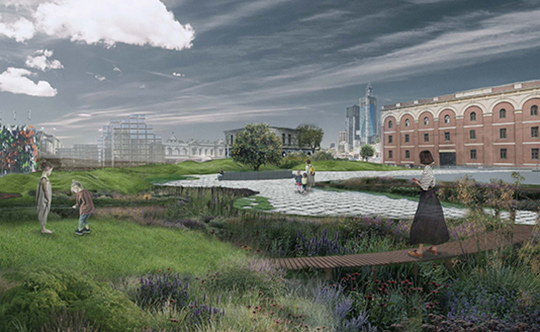Studio 2
Landscape Studio 2: Site and Design
Fiona Johnson

Studio Description
This studio follows a multi-objective approach in exploring the interrelation between site and design in landscape architectural practice. Site exploration and conceptual design aspects of site transformation are introduced, alongside 3D representation techniques. Emphasis will be given to a process-based approach in the idea generation to formulate creative, integrative, and cohesive design responses to a set design brief.
The urban metropolis is subject to the pressures of densification, changing climate and changing patterns of production and consumption. This studio asks students to speculate on Melbourne’s unsettled future, beginning with group work explore the political ecology of site and examining the potentials of this entanglement. Individual design work will be ideated through physical modelling techniques, digital modelling techniques, conventional drawings, and diagramming across spatial scales.
Studio Outcomes
- Critical and Analytical thinking: To critically interrogate landscape sites and precedents and apply landscape theories and practices in design thinking
- Design process: To understand and apply a range of processes and techniques for exploring sites and generating multiple design outcomes
- Communication: To effectively represent and communicate design ideas in 3D with special focus on digital media
- Evaluation: To test and critically evaluate design outcomes and formulate a final design response
- Lateral and critical thinking through design experiments and making
- Leadership and effective teamwork organisation
Studio Leaders
Dr Fiona Johnson is Landscape Architect with a background as a professional researcher, educator and academic. Fiona is Director and Studio Manager at Lucernal, a creative digital studio working across built and imagined environments, including architectural visualisation across multiple sectors, and more recently video game development. She has extensive teaching experience in contemporary theory, digital design, and representation for landscape architecture. Her research and writing on politics, civic space and decolonisation have been published in peer-reviewed journals and conferences, as well as publications such as Landscape Architecture Australia.
Readings & References
- Dunne, Anthony, and Fiona Raby. Speculative Everything: Design, Fiction, and Social Dreaming. MIT press, 2013.
- Haraway, Donna J. Staying with the Trouble: Making Kin in the Chthulucene. Duke University Press, 2016.
- Danny Hillis (2016). ‘The Enlightenment is Dead, Long Live the Entanglement.’ Journal of Design and Science.
- Rob Holmes,(2020) ‘The Problem with Solutions,’ Places Journal, July 2020.
- Lahoud, Adrian. "Post-Traumatic Urbanism." Architectural Design 80, no. 5 (2010): 14-23.
- Kees Lokman, (2017) Cyborg landscapes: Choreographing resilient interactions.
- between infrastructure, ecology and society,’ Journal of Landscape Architecture, 12:1, 60-73.
Schedule Lectures Mondays 09:00-10:00; Tutorials Mondays 09:00-15:15